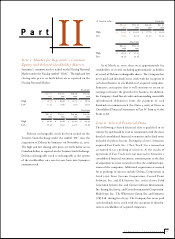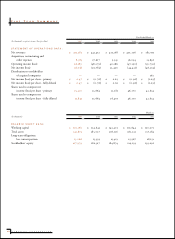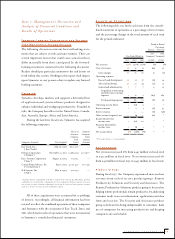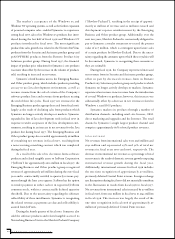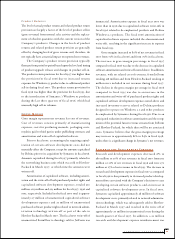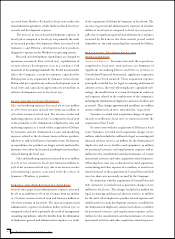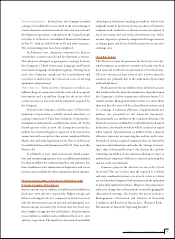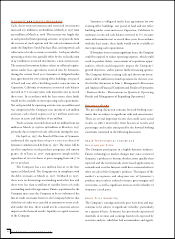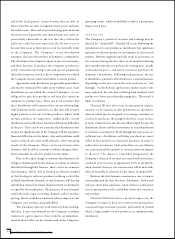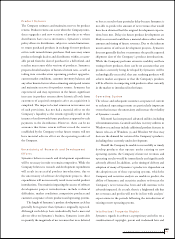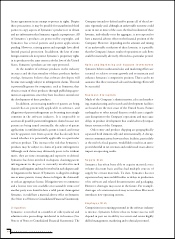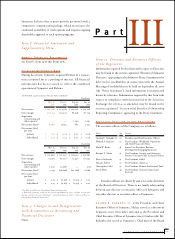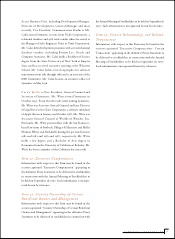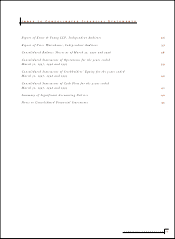Symantec 1997 Annual Report Download - page 28
Download and view the complete annual report
Please find page 28 of the 1997 Symantec annual report below. You can navigate through the pages in the report by either clicking on the pages listed below, or by using the keyword search tool below to find specific information within the annual report.
end of the fiscal quarter, in part because they are able, or
believe that they are able, to negotiate lower prices and more
favorable terms. This end-of-period buying pattern means
that forecasts of quarterly and annual financial results are
particularly vulnerable to the risk that they will not be
achieved, either because expected sales do not occur or
because they occur at lower prices or on less favorable terms
to the Company. The Company’s retail distribution
customers also carry the products of Symantec’s competitors.
The distributors have limited capital to invest in inventory,
and their decisions to purchase the Company’s products is
partly a function of pricing, terms and special promotions
offered by Symantec as well as by its competitors over which
the Company has no control and which it cannot predict.
Agreements with distributors are generally nonexclusive
and may be terminated by either party without cause. Such
distributors are not within the control of Symantec, are not
obligated to purchase products and may also represent
competitors’ product lines. There can be no assurance that
these distributors will continue their current relationships
with Symantec on the same basis, or that they will not give
higher priority to the sale of other products, which could
include products of competitors. Additionally, certain
distributors and resellers have experienced financial difficulties
in the past. There can be no assurance that distributors that
account for significant sales of the Company will not experience
financial difficulties in the future. Any such problems could
lead to reduced sales and could adversely affect operating
results of the Company. There can be no assurance that
Symantec will be able to continue to obtain adequate distri-
bution channels for all of its products in the future.
Due to the rapid change in software distribution tech-
nology as demonstrated by the increase in volume of software
distributed through the Internet, there can be no assurance
that Symantec will be able to develop an effective method
of distributing its software products utilizing each of the
available distribution channels or that Symantec will develop
distribution channels for those channels which are ultimately
accepted by the marketplace. The presence of new channels
could adversely impact existing channels and/or product
pricing, which could have a material adverse impact on the
Company’s net revenues and profitability.
The Company operates with relatively little backlog;
therefore, if near-term demand for the Company’s products
weakens in a given quarter, there could be an immediate,
material adverse effect on net revenues and on the Company’s
operating results, which would likely result in a precipitous
drop in stock price.
Channel Fill
The Company’s pattern of revenues and earnings may be
affected by “channel fill.” Channel fill occurs following the
introduction of a new product as distributors buy significant
quantities of the new product in anticipation of sales of such
product. Software upgrades typically result in an increase in
net revenues during the first three to six months following
their introduction due to purchases by existing users, usually
at discounted prices, and initial inventory purchases by
Symantec’s distributors. Following such purchases, the rate
of distributors’ purchases often declines in a material amount,
depending on the rates of purchases by end users or “sell-
through.” As the desktop applications market has become
more saturated, the sales mix is shifting from standard retail
products to lower priced product upgrades. This trend is
likely to continue.
Channel fill may also occur in anticipation of price
increases or in response to sales promotions or incentives,
some of which may be designed to encourage customers to
accelerate purchases that might otherwise occur in later
periods. Channels may also become filled simply because the
distributors do not sell their inventories to retail distribution
or end users as anticipated. If sell-through does not occur at a
sufficient rate, distributors will delay purchases or cancel
orders in later periods or return prior purchases in order to
reduce their inventories. Such order delays or cancellations
can cause material fluctuations in revenues from one quarter
to the next. The impact is somewhat mitigated by the
Company’s deferral of revenue associated with inventories
estimated to be in excess of appropriate levels in the distrib-
ution channel; however, net revenues may still be materially
affected favorably or adversely by the effects of channel fill.
Between the date Symantec announces a new version or
new product and the date of release, distributors, dealers and
end users often delay purchases, cancel orders or return prod-
ucts in anticipation of the availability of the new version or
new product.
Channel fill did not have a material impact on the
Company’s revenues in fiscal 1997, 1996 or 1995 but may have
a material impact in future periods, particularly in periods
where a large number of new products are simultaneously
introduced.
26 SYMANTEC CORPORATION



